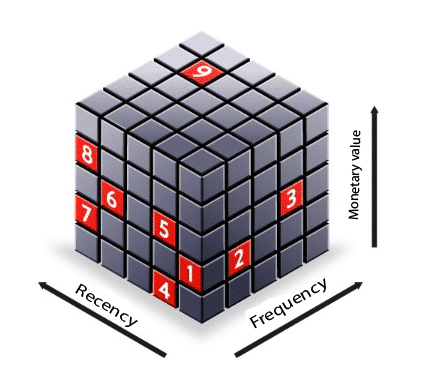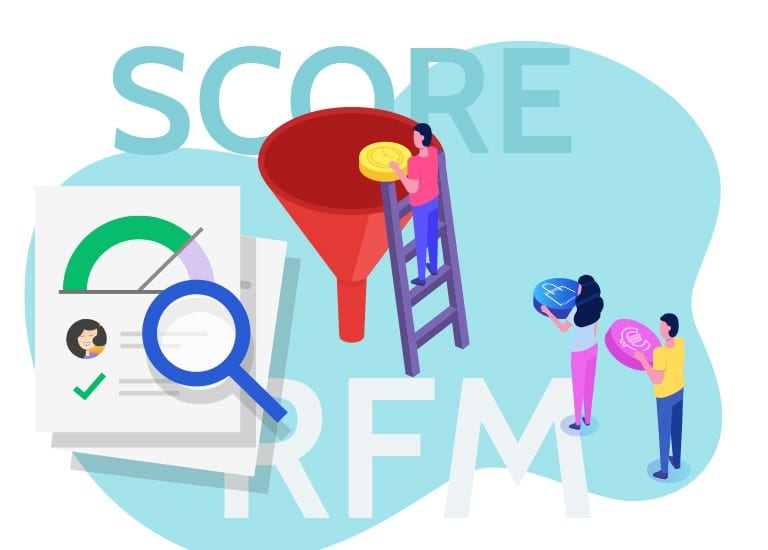What is a Member Engagement score?
In the race to retain your members or donors, it is essential to know their purchasing or donation behaviour. These so-called behaviours can be identified according to 3 criteria: the recency and frequency of purchases as well as the number of transactions. The reconciliation of these 3 criteria makes it possible to give a score to its targets according to 9 profiles that can be placed in a cube (or triaxial table):
- Long lost members
- Unconfirmed members
- Recently lost returning members
- Recent members with modest transactions
- Recent high transaction members
- Regular members in decline
- Regular members with modest transactions
- Regular members developing
- Regular members with high transaction

Knowing this, it will be easier for you to determine which segments / profiles are intended for which actions and which marketing campaigns. Each of these profiles can be the subject of a specific strategy, you are then more relevant in your interactions and thus optimise your chances of conversion and / or retention.
How to properly measure Member Engagement?
We recommend utilising RFM when evaluating Member Engagement. R for “Recency”, F for “Frequency” and M for “Monetary” For each variable (R, F and M), it is essential to determine the criteria in order to simplify its use. But be careful, if there are too many criteria, you risk increasing the number of profiles. However, it would be ridiculous to work with more profiles than the 9 previously identified.
For example:
- The Recency can offer periods of seniority: “less than one year”, “between 1 and 3 years”, “between 3 and 5 years”, “more than 5 years”, …
- The Frequency can be divided into time slices: “several times a month”, “once a month”, “several times a year”, “once a year”, “less than once a year”, etc.
- The Monetary Value can be segmented by bracket: “from 0 to £1,000”, “from £1,001 to £2,000”, etc.
The important thing is that these criteria are in line with the products and services of your organisation. We recommend that you do not exceed 5 representative brackets per variable.
Then, you must assign a score to each criterion of each variable (from 0 to 4 for example). This will give you 3 coordinates that will allow you to place the client (or donor within the framework of an NFP) in your triaxial table. It should theoretically be closer to one of the 9 profiles.
You can also accumulate all the points in order to give an overall rating to each member in order to determine its commercial value for your organisation.
If you wish to evaluate your Member Engagement further, you can adopt the RFM-I score (frequency, recency, monetary value, interactions). You keep the RFM to which you add the purchased product category. This will allow you to work on the up-sale of your members.
Member Engagement using RFM and CRM
Because you track when your member last bought, the average regularity they use your services, and the average amount they spend, this method can predict potential customer behaviours. When properly analysed, these elements can be used by your sales department to establish the forecast of activity. For the marketing department, this data can allow them to revive a customer and therefore prevents him from disengaging.
As all of the data is contained within the CRM solution you can track your relationship with each member (purchases, interactions, campaigns, etc.) and assign them a score. Thanks to this collaborative tool, you are able to share information about your members so that each department can take advantage of available data. So, at a glance, it’s easy to know specifically what action to take with which member. As part of a campaign, segmentation by RFM score will target an entire group on a given communication.
Even more scores!
As we said, the RFM score is among the most common when measuring Member Engagement. But maybe it doesn’t suit you? Of course, you can choose the rating criteria that are more relevant to your industry and your business: engagement rate, risk, profitability, seniority, potential, etc.
With the Eudonet CRM, take advantage of all the power of the Score extension available in the EudoStore to help you evaluate your Member Engagement. Choose your own criteria and automate the rating of your current members and prospects!


